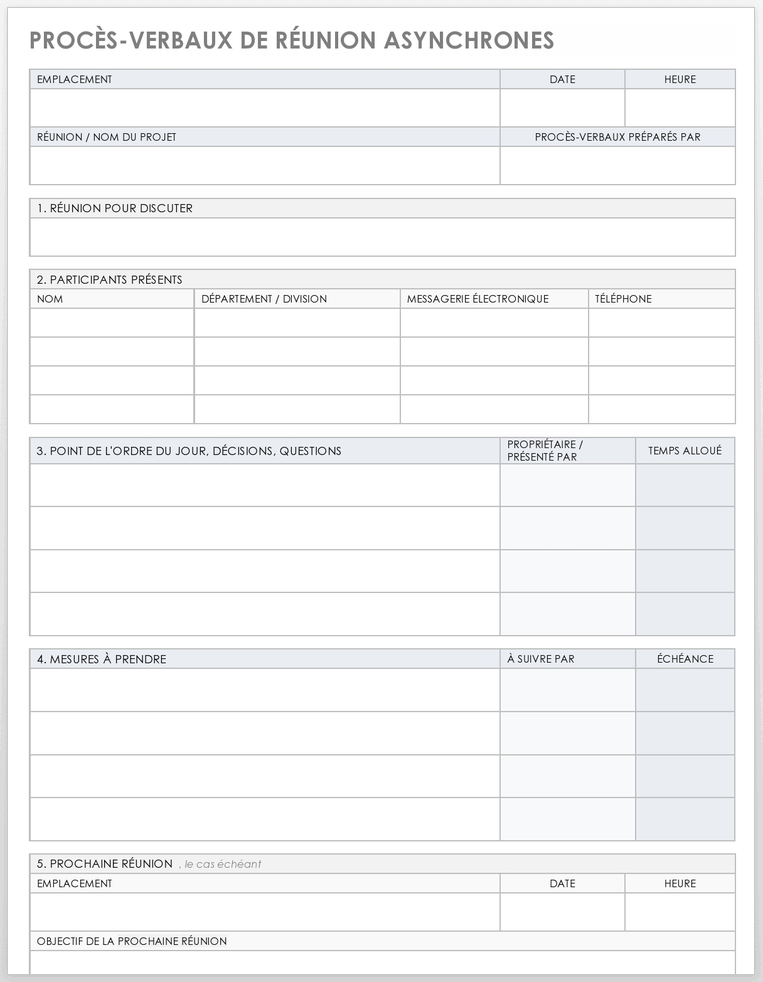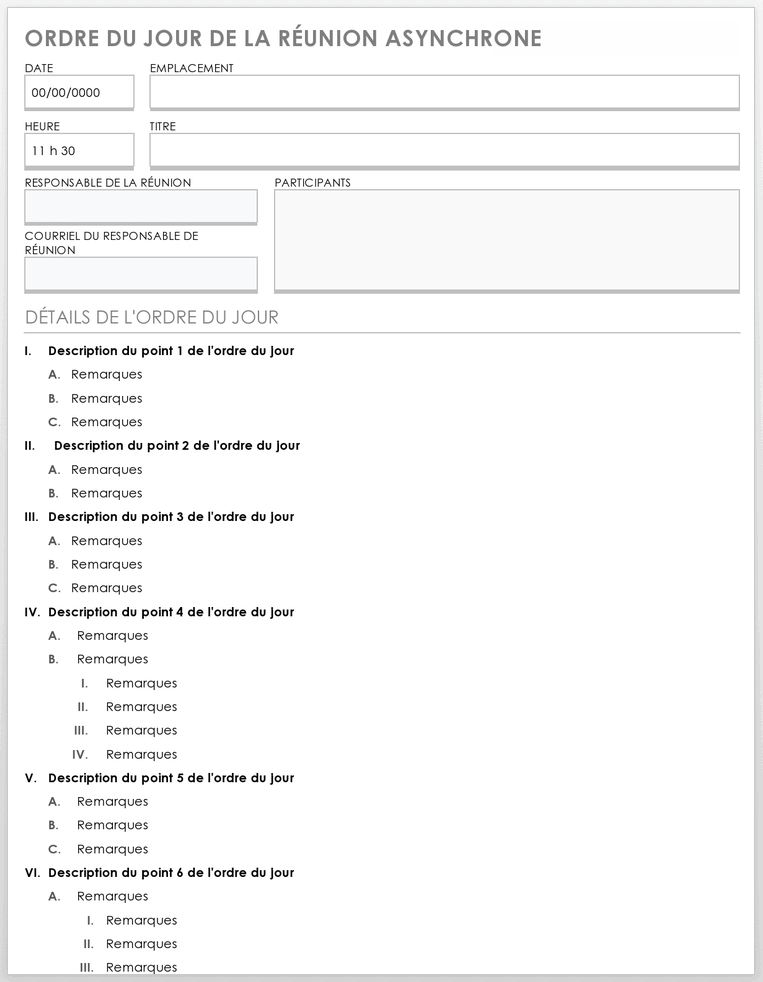Qu’est-ce que la communication asynchrone ?
Asynchronous communication is the intermittent transmission of data that does not require an immediate response.
One can communicate asynchronously without having to be physically present. For example, the following scenario can be considered an example of asynchronous communication: You send an email; the recipient of this email reads the message, but replies to it later.
Asynchronous communication plays a huge role in remote work. Experts even say it's the future of successful telecommuting. Due to its flexible nature, this type of communication allows you to stay productive while maintaining a work-life balance. If your job doesn't require you to be constantly online, you have more control over your time.
This type of communication is especially useful for remote workers and distributed teamsacross multiple sites, as work responsibilities can be organized around personal responsibilities, rather than adhering to rigid office hours. Asynchronous communication allows people to respond when they are ready and available, having had enough time to think about the message or question at hand.
Exemples de communication asynchrone
The Internet has revolutionized asynchronous communication and allowed it to become efficient. Here are some examples of asynchronous communication:
- Messenger Apps
- Status updates (at project, team or organization level)
- Weekly announcements (introducing new hires, company-wide announcements, etc.)
- Chat-based standup apps (Slack, etc.), especially for distributed software development teams
- Intranet (Yammer, etc.)
Avantages de la communication asynchrone
Asynchronous communication has many advantages. It improves productivity, the quality of communication and documentation, and the overall morale of team members. It also allows for more flexible planning.
Here are the many benefits of asynchronous communication:
- Increased flexibility: People using asynchronous communication methods do not need to respond immediately to messages, emails or chat interventions they receive.
- More thoughtful communication: With more time to think about a response and consider all potential scenarios, you are able to communicate more accurately, honestly, and thoughtfully.
- Better documentation and more transparency: Thanks to automatic archiving, asynchronous communication methods allow you to record comments, messages, e-mails etc. This way, you can access your documentation at any time, avoiding communication redundancy and improving productivity.
- Happier workers: When people have more control over their workday and the ability to choose their schedules, they are generally happier. This autonomy allows employees to structure their time according to their lifestyle. When managers and co-workers don't demand or expect an immediate response, workers can focus on their own work and respond at their convenience. In addition, happier workers are less stressed, and therefore tend to enjoy better mental and physical health.
- Increased productivity: Because employees don't have to devote themselves as heavily to answering emails or chatting, they have more time for complex and more valuable work. Your team members are also able to get more work done in less time, allowing them to spend longer time slots on that more important work. Because they focus on the work that matters, rather than drowning in emails, productivity increases.
- Better planning: With less stress and fewer distractions, it's possible to plan work days more thoughtfully and spend more time on the work that matters.
- Fewer time zone issues: Asynchronous communication helps level the playing field between employees based in diverse geographies. Now, employees can send, view and reply to messages when they are available, allowing companies to retain them and expand their hiring pool.
- More autonomy and responsibility: When someone can structure their schedule according to their needs, they feel more empowered and independent. And an employee who has more control over their life is more loyal, stays with the company longer, and produces better quality work.
Difficultés de la communication asynchrone
While there are many advantages to implementing asynchronous communication methods, it also presents some challenges. These include longer resolution times, more misunderstandings and fewer brainstorming sessions.
Comment créer une culture plus asynchrone
To create a more asynchronous culture among your team members, follow the key steps below:
- Assess your business needs: Before trying to implement a variety of new tools and techniques, take the time to analyze the needs of the business you are trying to meet.
Amira Hankin is a senior product designer at Stamen , a strategic design firm with expertise in data visualization and mapping. “Assess your business needs to better choose the tools that support your larger goals,” she explains. When looking at these needs, you should "think carefully about the tools you select, and why you choose them."
- Overcommunicate: When contacting team members, include as much detail as possible in each message, such as screenshots, data, and slides. Be absolutely clear about your requests and related deadlines.
- Leave time to respond: The principle, and the advantage, of asynchronous communication is that you can respond at your own pace, after having given enough thought to your response. Given this flexibility, consider allowing a few hours (or even days) for people to respond. In the meantime, use your time productively, and do whatever you can.
- Ensure access to all necessary documents: If you have to wait for authorization to view or modify, this adds unnecessary delay to an already slow form of communication. For this reason, make sure in advance that everyone has the appropriate permissions for all documentation.
- Share relevant information beforehand: Before a meeting or a call, make sure everyone has all the necessary information at their disposal, so that they can actively contribute to the conversation.
- Document all discussion topics: Be sure to jot down all discussion topics and action items during your meeting, so everyone can easily find the information later and refresh their ideas. Better yet, record the meeting (if possible) so people can view it at their convenience.
- Turn off notifications: During highly concentrated work time and after hours, be sure to turn off notifications from emails, chat apps, and other forms of communication. Block specific times of the day to respond to all notifications, to maximize your productivity.
- Promote this new type of communication constantly: As mentioned earlier, implementing a whole new form of communication can be challenging. Lead by example and foster asynchronous communication between your team members to ensure everyone aligns with this new process.
Comment les leaders peuvent favoriser la communication asynchrone au sein de leur équipe
Leaders drive change in an organization, especially when that change involves the way team members communicate with each other. To create a fully functional asynchronous organization, consider the points below:
- Eliminate mandatory working hours, especially in the office.
- Emphasize trust and accountability within your organization.
- Set team-wide expectations for response times for emails, chat apps, and more.
- Implement a DRI (directly accountable individual) management model .
- Emphasize transparency and use communication tools that promote it.
- Have specific ways to communicate if an urgent need arises.
- Give team members flexibility, and let them know that it's okay not to be available all the time. Model this behavior yourself.
- Foster strong and effective communication, which is the backbone of asynchronous communication.
- Evaluate employees based on their output, not the number of hours they spend at their desks.
Meilleures pratiques en matière de communication asynchrone
To fully embrace and utilize asynchronous communication, follow the best practices outlined below:
- Realize that most things aren't urgent: One of the most important aspects of implementing asynchronous communication is realizing that almost anything can be waiting for a response. Whether someone responds within five minutes or five hours, it probably won't hamper your productivity. If something is really urgent, decline meetings, offer asynchronous communication methods, and send a direct message only to staff members affected by this emergency.
- Have clear processes: Help employees distinguish between when they need to send emails or asynchronous chat messages, and when they need to schedule a meeting. This helps reduce the amount of stress people feel when it comes to responding to messages and using the right kind of communication. Likewise, use clear processes for when and how to document relevant information, so you don't miss any details.
- Allocate time effectively: While you wait for a response from a team member, work on another project, so you don't sit idle. This way, you can also work on any projects that may be holding you back, and make repeat improvements to other projects while you wait.
- Fully understand the nonlinear workday: More than ever, people work at different times of the day, especially when they live in different time zones. Consider this factor when implementing asynchronous communication, and consider altering your schedule to better suit your own productive hours. Try different work schedule distributions, and know that an asynchronous organization will fully support these varied schedules.
- Use convenient tools: Another key part of effective asynchronous communication is having a tool that allows you to document and store all information in one place where everyone can access what they need and get updates. updated in real time. Find a tool that creates that single source of truth, so everyone can stay in the loop.
- Get full support from everyone on the team: When integrating new tools into your processes, "it can be difficult to implement [these tools] if there's no buy-in from the from all team members," says Hankin. To mitigate this issue, make sure you have ongoing conversations about changes to tools or communication, "whether it's one-on-one conversations or discussions with your boss's boss about how and the reason for using these tools," notes Hankin.
- Aim for progress, not perfection: Asynchronous communication will take some getting used to. Give people time and celebrate the small victories that come from this new form of communication, like more productive hours in the day and more flexible schedules for employees.
Meilleures pratiques en matière de communication asynchrone au sein de votre équipe et sur votre lieu de travail
To maximize the benefits of asynchronous communication within your team, and even your entire organization, apply some best practices to your approach. Here are some useful tips to keep in mind:
- Make all important information available in advance.
- Write clearly, precisely and thoughtfully.
- To maximize productivity, block off your day, so team members know when you're available and when you're offline.
- Group your emails and correspondence into a few time slots during the day, and set up an auto-reply for times when you expect to be inactive on email.
- Share your talk times and preferences with team members, so they know when you're most responsive.
- Send all notifications, chats, and emails with context to give team members enough information to act on the message.
- Avoid unnecessary @ mentions and direct chat.
- Strive to reduce your reliance on synchronous communication tools. Try removing these tools from your phone, so you don't feel pressured to respond to messages all the time.
To learn how asynchronous tools can help your team be more productive, check out our ultimate guide to asynchronous communication and collaboration tools .
Meilleures pratiques pour les réunions asynchrones
Once you embrace these asynchronous forms of communication and begin to practice them, you will also begin to implement asynchronous meetings. To run the most effective meetings using this new type of communication, apply the following best practices:
- Share the agenda beforehand, so meeting participants are aware of the topics of discussion and can add notes.
- Use a central portal and share it with team members, so everyone can easily upload and collaborate on notes, schedules, progress updates, and reference materials.
- Implement a project management system that lets you create workflows, so team members can keep track of their daily tasks across multiple projects .
- Use an asynchronous video tool that allows you to share messages with as many people as needed. This will allow everyone to view a video or review a slideshow at their convenience.
- Ask yourself honestly whether or not a meeting can be done in writing. If you feel a meeting is necessary, set a concrete agenda with action items.
- Host a post-mortem meeting to determine if a synchronous meeting was successful or if you could have hosted it asynchronously.
- Encourage everyone to speak up during asynchronous meetings.
- Set rules for the types of comments and interventions during a meeting, and keep the meeting under control and on track as it progresses.
Modèles de communication asynchrones
Modèle d’ordre du jour de réunion asynchrone
Download the asynchronous meeting agenda template
Utilisez ce modèle utile pour définir un ordre du jour de réunion asynchrone. Répertoriez tous les éléments essentiels de votre réunion, y compris les participants, les objectifs généraux, un emploi du temps de la réunion minute par minute et les coordonnées du responsable de la réunion.
Ce modèle garantit que votre réunion asynchrone fera bon usage du temps de chacun.
Modèle de procès-verbaux de réunion asynchrone
Téléchargea le modèle de minutes de réunion asynchrone
Utilisez ce modèle pratique de minutes de réunion pour rester organisé et garder tout le monde sur la même longueur d’onde pendant votre réunion asynchrone.
Designed specifically for asynchronous communication, this template lets you list meeting attendees and agenda, track decisions and issues, and brainstorm action items, so everyone can stay up-to-date. follow the plan as the meeting progresses.
Qu’est-ce que la communication synchrone ?
Synchronous communication , which is the antithesis of asynchronous communication, refers to the real-time, anytime communication that you typically do in person.
When practicing synchronous communication, people respond immediately and learn new information in the moment. Synchronous communication includes for example on-site meetings, real-time chats, phone calls, etc.
La différence entre la communication d’équipe asynchrone et synchrone
Synchronous communication happens in real time and requires immediate responses, whereas asynchronous communication does not happen instantaneously and allows for varied response times.
Many organizations have embraced asynchronous communication because its increased flexibility gives employees more control over their schedule, determining themselves when to respond to emails, chats, or other notifications. This method also gives each team member more autonomy, reducing the stress associated with always being online and reducing the need to coordinate the jobs of geographically diverse staff.
Synchronous communication, on the other hand, emphasizes deadlines and response times, which can add stress and potentially lead to burnout. This method also creates a constant threat of interruptions through email, chats or other forms of communication. By definition, synchronous communication divides attention, making it increasingly difficult to focus deeply on specific work.
Moreover, the expectation of immediate responses in synchronous communication diminishes the quality of these responses; which ultimately requires more discussion and leaves less time to find optimal solutions. Synchronous communication tends to prioritize connectivity over productivity, creating an environment that doesn't always provide the best solutions for your organization.
Trouver un équilibre entre la communication asynchrone et la communication synchrone
Although asynchronous communication is becoming increasingly popular, there are instances where synchronous communication makes more sense.
Synchronous communication is more suitable in the following cases:
- Superficial, less serious work (eg, answering emails or chats, arranging logistics, or scheduling status meetings)
- Team building, casual meetings or socializing between teams and organizations
- Urgent situations that require an immediate response (e.g. when a server is down)
- Collaboration or brainstorming sessions
- Seminars, celebrations or coworking situations
- Problems solving
- First meetings with external parties or suppliers
- All emotionally sensitive topics requiring face-to-face discussion
Asynchronous communication is more suitable in the following cases:
- Complex and intense work that requires more time and energy (e.g. finding a solution to a problem, writing a launch plan or campaign brief, or creating a presentation)
- Company discussions and news
- General Comments
- Introducing new team members
- Detailed technical conversations
- Project discussions
Mettez en œuvre une communication asynchrone efficace avec Smartsheet



